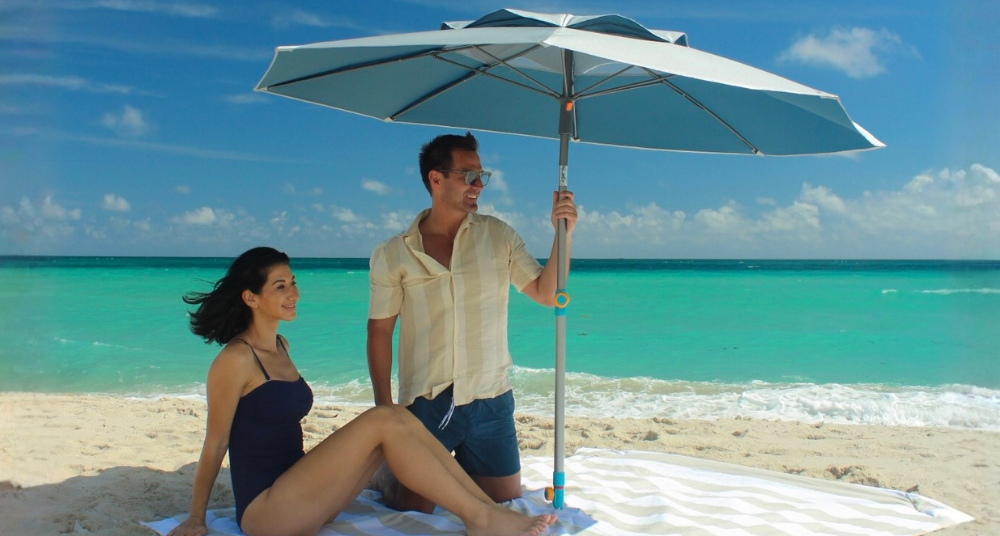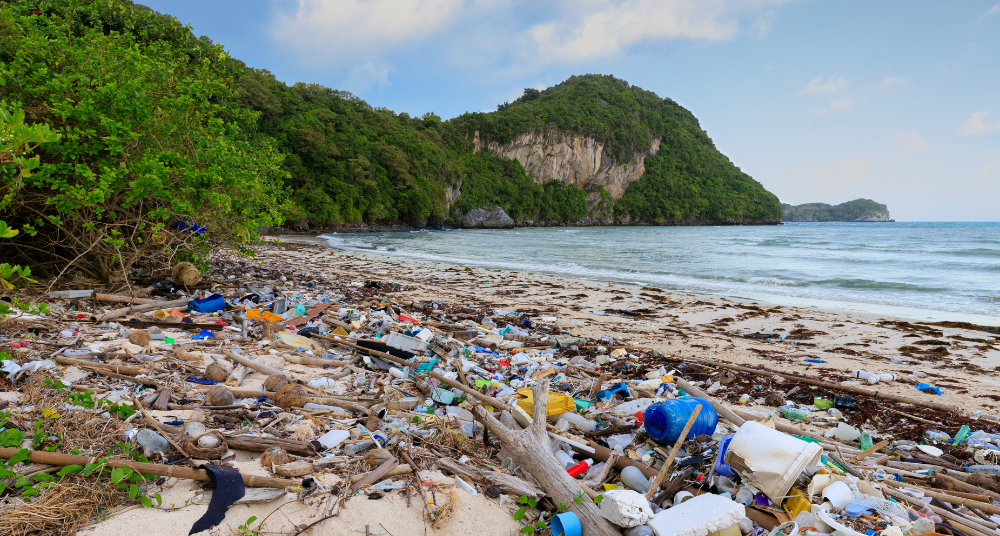Last updated: October 2025
30-second takeaway:
UPF is fabric protection; SPF is skin protection. Start with dense, reflective shade (UPF 55+) to block most UV before it reaches you, then back it up with broad-spectrum sunscreen for the bounce off sand and water. Stable shade matters—when your canopy stays put, your protection does too.
UPF vs SPF, in plain English
UPF measures how much UV a fabric lets through in lab tests. A UPF 50+ canopy allows no more than ~2% of UV to pass. SPF measures how long skin takes to redden with sunscreen applied under controlled conditions. On the beach you need both: shade cuts direct overhead UV; sunscreen covers exposed skin and the scattered/reflected light you can’t avoid.
(Internal read: “Beach umbrellas miss the mark on UV — here’s what to look for”
Why the canopy itself matters
Fabric density and weave are your first line of defense. Thicker, tighter-weave fabric reduces UV pathways; a reflective (silver) outer canopy bounces part of the UV and heat away before the fabric warms, so the shade below feels cooler. Real life beats lab life: wet, stretched, or worn fabric can let through more UV over time, so quality materials pay off over many seasons.
Sunscreen is still non-negotiable
Even under great shade, UV finds you from the sides. Use broad-spectrum SPF 30+ on all exposed skin and reapply as directed—especially after water or sweat. Add a hat, sunglasses, and UPF clothing to close common gaps like shoulders, noses, ears, and the tops of feet. For practical guidance, the American Academy of Dermatology is an excellent reference. (External: AAD Sun Protection)
Steady shade = steadier protection
If your canopy wanders with gusts, your coverage does too. Vented canopies release pressure so they don’t balloon; deep, hammer-in anchors seat quickly and resist spin in sugar sand. A setup you can place once and trust keeps your protection where you intended it for the long haul of the day.
Wind-powered shade might not be consistent shade
Sail- or wind-powered canopies look airy on breezy days, but the shade moves with the wind. When the breeze shifts—or drops altogether—coverage wanders and shoulders, backs, and feet slip into direct sun. That’s a UV issue (gaps in protection) and a comfort issue (you keep chasing shade instead of relaxing). For long beach days with kids, snacks, and naps, a vented, anchored canopy keeps your protection where you planned it.
(Internal read: Wind safety: how to keep shade stable on gusty days
What we build into Handy (so the plan actually works)
- UPF 55+ reflective (silver) canopy to help block more UV and shed heat.
- Dense, tight-weave 160 gsm RPET—about ~80 recycled bottles per canopy.
- Vented canopy + reinforced hardware for calmer shade in gusts.
- 10-second install with a deep-set, hammer-in steel anchor (not twist-only).
- Independently tested to ASTM F3681-24 (or ASTM-informed methods where applicable) for safer hold in wind.
Stay cool, stay protected — explore our silver-lined Handy Beach Umbrella and Anchor System
Five things most people miss (but matter a lot)
- Angle and re-angle: As the sun moves, so should your pole angle; tiny tweaks keep shoulders and knees in shade at midday.
- Low-glare beneath the canopy: Reflective outer + thoughtfully finished underside = bright protection without harsh glare on eyes.
- Wet fabric ≠ same protection: Some fabrics transmit more UV when wet or stretched. Dense, quality canopies hold their rating better.
- Feet + ears get roasted: Sunscreen those “forgotten zones,” even in shade—tops of feet, ears, and the back of the neck.
- Stability is safety: A steady, anchored umbrella not only holds UV coverage—it's safer for everyone around you.
A simple beach protection plan
- Set smart shade: High-UPF, reflective, vented canopy + deep-set anchor.
- Cover skin: Broad-spectrum SPF 30+, reapplied per label.
- Dress the gaps: Hat, sunglasses, UPF shirt.
- Mind the bounce: Reapply around noon and after swims.
- Stay comfortable: Hydrate; adjust angle as the sun moves.
FAQs
Does UPF replace sunscreen?
No. UPF stops much of the overhead UV at the fabric. Sunscreen protects exposed skin and the side-scatter you can’t block with shade alone.
What UPF rating should I look for?
UPF 50+ minimum; UPF 55+ preferred—paired with dense, tight-weave fabric and a reflective (silver) outer for cooler, safer shade.
Do I need sunscreen under an umbrella?
Yes. Sand and water reflect UV. Apply broad-spectrum SPF 30+ and reapply as directed.
Are wind-powered beach shades good for UV protection?
They can feel nice in steady wind, but coverage shifts as the breeze changes. That creates gaps—even with good fabric. A vented, anchored umbrella keeps shade (and protection) in place; pair it with sunscreen for scattered/reflected UV.
Does fabric lose protection when wet or stretched?
It can. Dense, quality fabrics maintain protection better; thin or worn material can transmit more UV.
About the author
Written by Agnes, co-founder of Handy Beach Goods and a Florida mom of two. After one too many sunburns under flimsy shade, she set out to design UPF-forward, wind-savvy shade that installs in ~10 seconds and actually stays put on real beaches.
Safety & compliance notes
- No shade is truly windproof. Always lower umbrellas in strong gusts or when unattended.
- Independently tested to ASTM F3681-24 (or ASTM-informed methods where applicable) for safer hold; follow local beach rules.
- Comparison disclaimer: Information reflects claims and standards at the time of writing; verify current specs.


